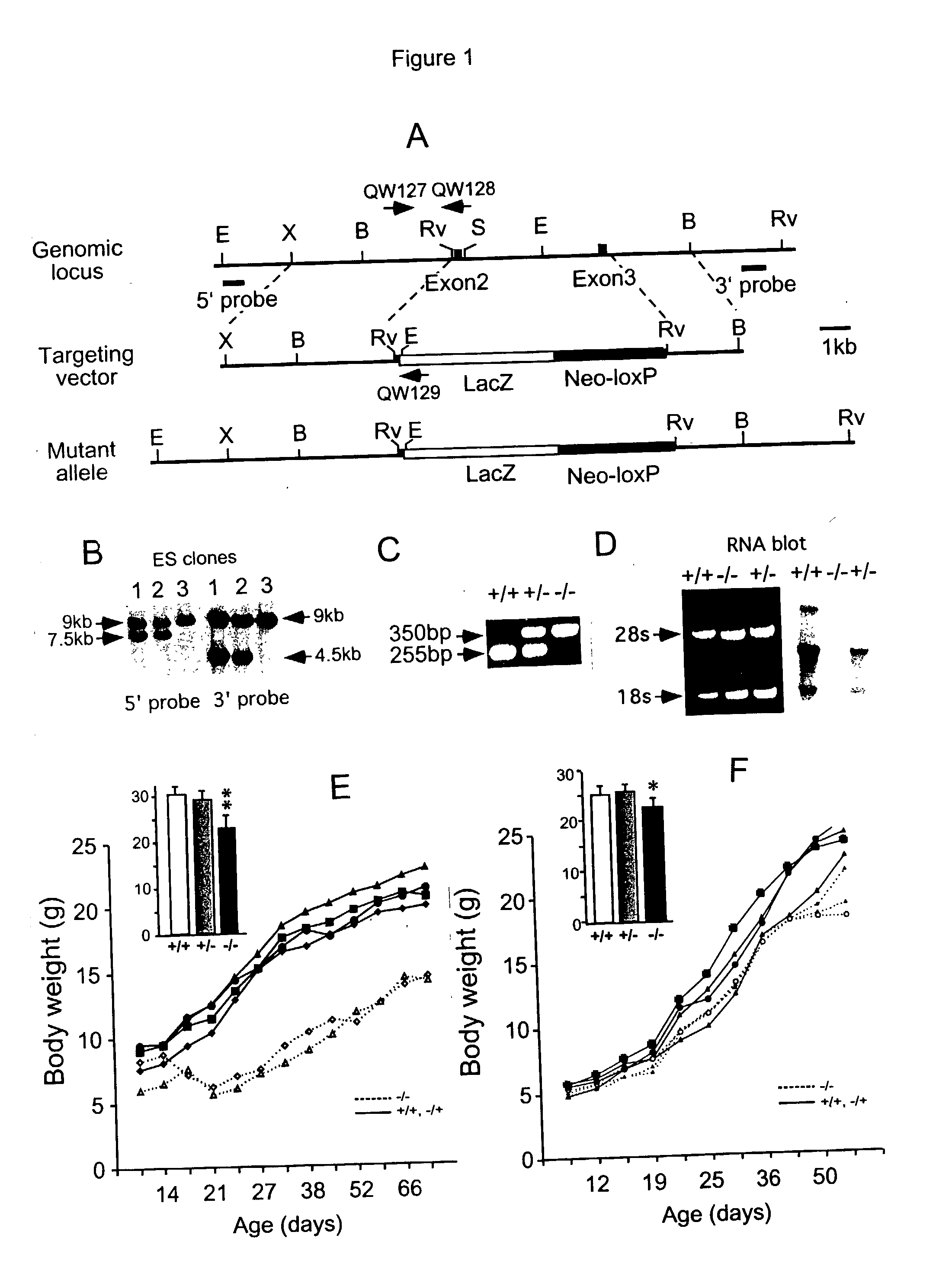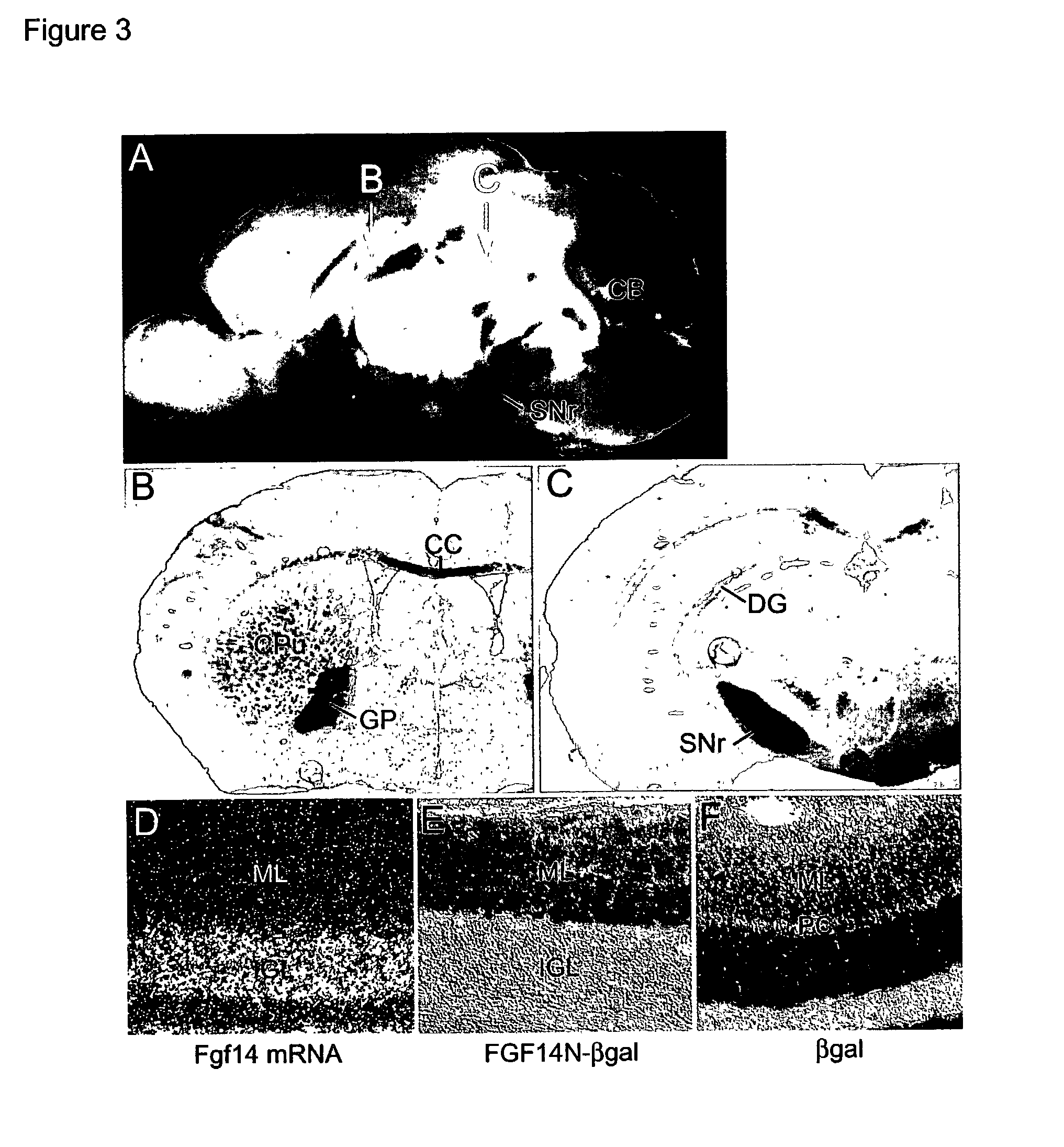Animal model with disrupted Fgf14 gene
a technology of fgf14 and fgf14 gene, which is applied in the field of animal models with disrupted fgf14 gene, can solve the problems of development defects and/or embryonic lethality, and the biological function remains elusive, and achieves the effect of efficient trafficking
- Summary
- Abstract
- Description
- Claims
- Application Information
AI Technical Summary
Benefits of technology
Problems solved by technology
Method used
Image
Examples
example i
Preparation and Neuropharmacological Testing of Fgf14 Deficient Mice
[0123] In this EXAMPLE I the in vivo activity of FGF14 was disrupted by homologous introduction of an Fgf14.sup.N-.sub..beta..sup.Gal allele which abolished FGF14 expression and generated a fusion protein (FGF14N-.beta.gal) between the first exon of FGF14 and .beta.-galactosidase. Fgf.sub.4.sup.N-.sub..beta..sup.Gal was localized in the basal ganglion and cerebellum, regions of the brain that regulate motor behavior. Strikingly, FGF14N-.beta.gal chimeric protein was efficiently trafficked into neuronal processes. Fgf14 deficient mice were viable, fertile and anatomically normal, but developed ataxia and a paroxysmal hyperkinetic movement disorder.
[0124] Neuropharmacological studies in this Example showed that the Fgf14 deficient mice have disrupted striatal-nigral and striatal-pallidal pathways resulting in increased excitatory input to the cortex. The paroxysmal hyperkinetic movement disorder in Fgf14 deficient mic...
example ii
[0203] In this EXAMPLE II, the transgenic knockout mouse (FGF14 KO) of EXAMPLE I was evaluated in a learning / memory test. This test evaluates Pavlovian types of conditioning to the context under which the mice are shocked or given an auditory cue (tone or white noise soundburst) that was paired with the shock.
[0204] A test was conducted on the conditioned fear task using the FGF14 KO and WT mice after they had been subjected to a series of drug challenges. The mice were run in a newly acquired conditioned fear system which uses a computerized digital image system to automatically quantify freezing behavior. Using this system it was found that there were very large differences between FGF14 KO and WT mice on the contextual cue test (p<0.00005).
[0205] The FGF14 KO mice showed significantly less freezing compared to WT mice on 5 / 8 minutes tested where differences were marginally nonsignificant on 2 out the remaining 3 minutes. The FGF14 KO mice also showed less freezing that WT mice wh...
example iii
[0210] In this EXAMPLE III, synaptic localization of FGF14-1b in Neuroblastoma (Neuro-2a) cells was demonstrated, and lack of FGF14 was shown to cause elevated excitability in the hippocampal dentate gyrus.
[0211] Hippocampal Excitability
[0212] Mice were decapitated under halothane anesthesia. The brains were quickly removed and placed in cold oxygenated artificial cerebrospinal fluid (ACSF). Horizontal slices (.about.500 .mu.m thick =) of combined hippocampus and entorhinal cortex were taken from the ventral brain surface using a vibratome. Slices were incubated at room temperature in a humidified interface chamber for at least one hour. For physiological recording, individual slices were transferred to an interface chamber, where they were continuously superfused with oxygenated artificial cerebrospinal fluid and humified gas (95% O.sub.2, 5% CO.sub.2) at 34-35.degree. C. ACSF contained (in mM): NaCl 124, NaHC0.sub.326, KCl 2, KH.sub.2PO.sub.4 1.3, CaCl.sub.2 2, MgSO.sub.4 1.0 or 2...
PUM
| Property | Measurement | Unit |
|---|---|---|
| time | aaaaa | aaaaa |
| elapsed time | aaaaa | aaaaa |
| temperature | aaaaa | aaaaa |
Abstract
Description
Claims
Application Information
 Login to View More
Login to View More - R&D
- Intellectual Property
- Life Sciences
- Materials
- Tech Scout
- Unparalleled Data Quality
- Higher Quality Content
- 60% Fewer Hallucinations
Browse by: Latest US Patents, China's latest patents, Technical Efficacy Thesaurus, Application Domain, Technology Topic, Popular Technical Reports.
© 2025 PatSnap. All rights reserved.Legal|Privacy policy|Modern Slavery Act Transparency Statement|Sitemap|About US| Contact US: help@patsnap.com



